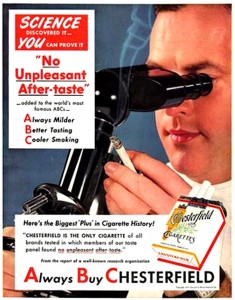Did you watch any of the Winston cigarette ads that used to play regularly on TV in the previous blog? The cleverly designed ads that drove people to addiction, suffering and often an early demise. Most offensive was the direct targeting to children. The ads expanded the limits of what it takes to be ‘cool’. My mother likes to tell the story of how her mother tried to get her to take up smoking because it was supposed to curb the appetite and help control your weight. Tobacco companies distributed cigarettes to servicemen with the eventual inclusion of cigarettes into rations. The industry bought their own doctors and medical ‘experts’ to help push their message. There was also a focus on the younger audience to prepare people to be lifetime customers and addicts. Major cigarette companies advertised on popular shows like the Flintstones and the Beverly Hillbillies.
Tobacco advertising was one of the most morally questionable industries. Studies would be cherry picked or fabricated to show only positive effects and minimize the negative outcomes. They would stop at nothing to exploit every possible resource- anything to sell more. Do you remember “I’d walk a mile for a Camel”, “What cigarette do you smoke doctor?”, “Us Tareyton smokers would rather fight than switch”‘ “More doctors smoke Camels”, “You’ve come a long way baby (Virginia Slims), “Smoke Old Golds for a treat instead of a treatment”….and many more ploys to engage susceptible people. Joe Camel, Willie the ‘Kool’ penquin and of course the Marlboro Man helped manipulate the mind and emotions into a world of lies and deceptions. At least four of the Marlboro Man models died of smoking related diseases.
 There was always a movement of doctors and organizations that knew this was wrong. It took decades for their voice to be heard loud enough for changes to be made. The tobacco industry recruited doctors that would bend science using money and influence. Finally a tipping point was reached as more people jumped on board to protest the lying and obvious manipulation of facts. The last cigarette ad ran at 11:50 pm during the Johnny Carson Show on January 1, 1971. Tobacco was the single largest product advertiser on TV in 1969. The makers defended their industry to attempt to negate the growing evidence that nicotine was addictive and increased cancer rates.
There was always a movement of doctors and organizations that knew this was wrong. It took decades for their voice to be heard loud enough for changes to be made. The tobacco industry recruited doctors that would bend science using money and influence. Finally a tipping point was reached as more people jumped on board to protest the lying and obvious manipulation of facts. The last cigarette ad ran at 11:50 pm during the Johnny Carson Show on January 1, 1971. Tobacco was the single largest product advertiser on TV in 1969. The makers defended their industry to attempt to negate the growing evidence that nicotine was addictive and increased cancer rates.
It’s 2016 and has anything really changed? The parallels and similar history of drug ads and cigarette ads are obvious. Selling sickness is a priority of drug dominated TV advertising. Doctors used to have more control on diagnosis and prescribing. Now the patient tells the doctor what they want based on the ad. It was more expensive attempting to directly educate doctors to prescribe their particular medication. Drug companies found direct-to-consumer ads work best. Today drug companies spent $5 billion a year on ads to consumers and another $7 billion for ‘free’ samples. The Nielsen Co. estimates 80 drug ads every hour of every day on American TV. America has the honor of paying the highest costs for drugs in the world.
Almost a third of the consumers who see a drug ad ask their doctor about it, and a majority of the patients get what they request. By appealing to the patients instead of doctors the cost of prescriptions has skyrocketed. Off-label prescribing and misuse of drugs has escalated as well. People commonly joke about the content of the ads and the horrible side effects that are described as a peaceful or fun situation plays to distract the viewer. The only other country that allows direct-to-consumer drug advertising is New Zealand. New Zealand has the highest density of sheep per unit area in the world. I’ll let the reader ponder that. I will try to sharpen my own radar to be mindful of my own gullible tendencies.
The content and devious advertising techniques of drug companies mirror the tobacco industry. Their strategies capitalize on people’s suffering and use celebrities, doctors, sex, children, the military, nostalgia, and strong emotive content to sway serious decisions regarding health. What drug companies are most concerned about is YOU!……You OPTING OUT OF THE HERD.
